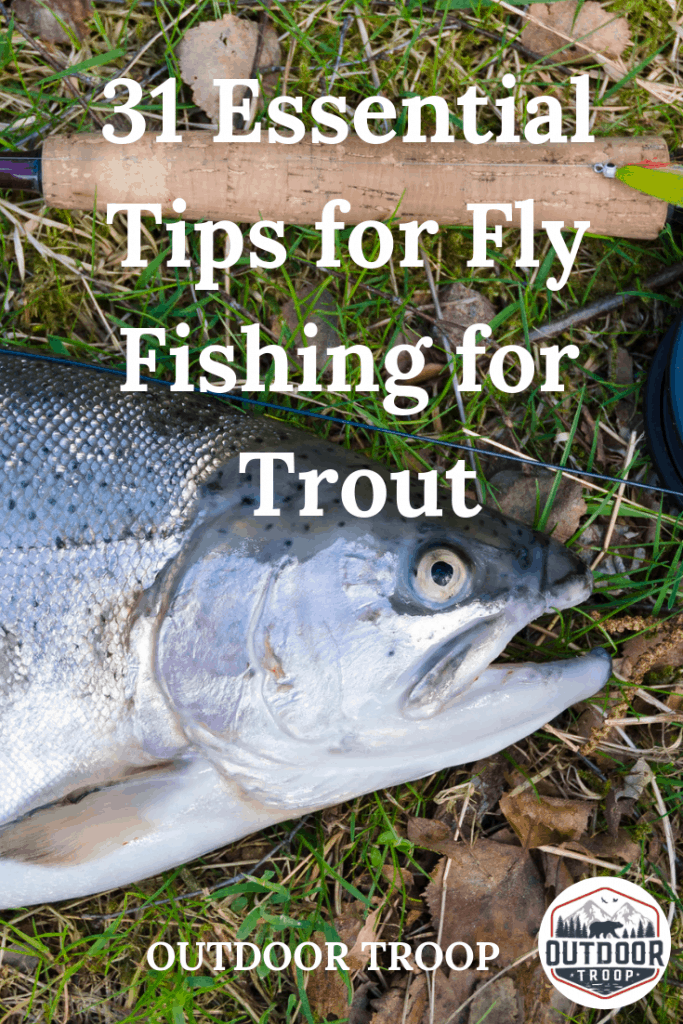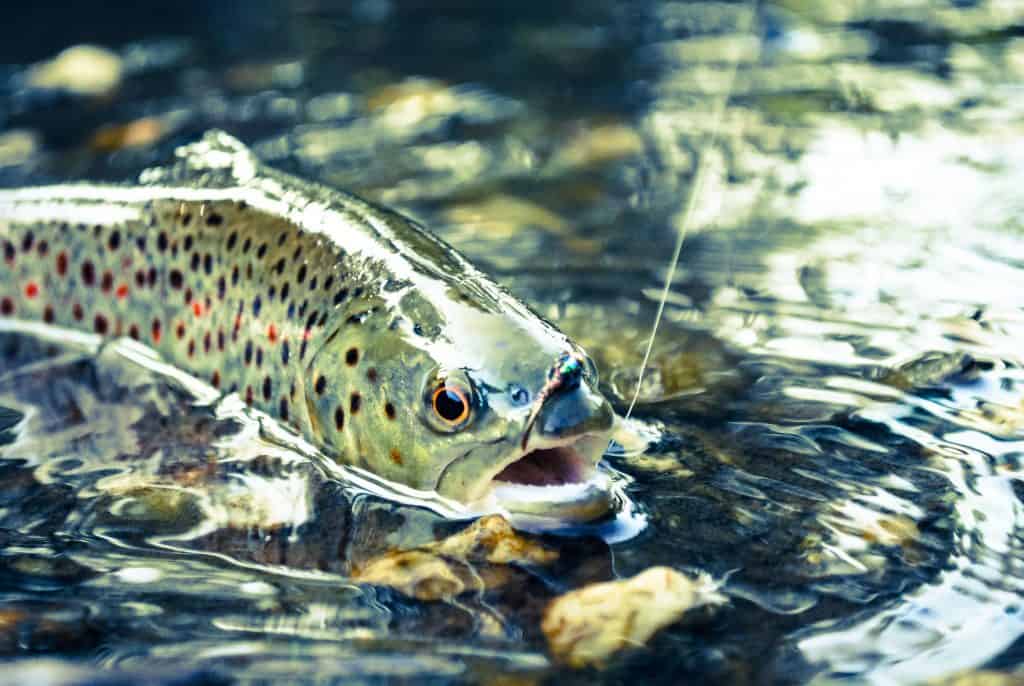
After fishing for trout for many years, I have learned a thing or two while fly fishing. Well, actually more than just a couple! Below is a list of 31 tips to help you catch more trout, become better at the sport, and have a better experience in general.
Tip 1: Be Quiet
Pole and body movement is so important when you’re targeting any fish. Trout can hear and feel much more than most people are aware of. Have you ever tried to crack your knuckle underwater with your head under as well?
If not, you should try it. It is unusually loud, and that is just a simple crack. Even little sounds and vibrations can travel a long way underwater. Fish can sense these disturbances easily and will be able to tell if something is wrong. Trout
Whether you are in the water or sometimes even walking along the side of the river bank, trout can hear and sense your movements. You’ll need to move slowly and quietly if you want to sneak up on them.
Tip 2: Dap and Dry
A lost tactic is a dap and dry. I always thought this technique was pretty popular, but it seems that it’s becoming less and less common. I still find it to be great for catching trout in areas where there isn’t much room to cast.
So you cast what you can, pull a little to the side the drift is coming from, then let it drift. Repeat this 7 or so times, then you get a full recast in. It allows you to get a fly into otherwise unreachable spots.
It can also be really effective if you are getting frustrated or don’t want to put in that much effort. This technique helps you cover a large distance without many casts.
Tip 3: Lose the Bobber
Forget the indicator when you’re nymphing deep, briskly paced runs. Given the top-to-bottom current differential and the weight needed to get the fly down, an indicator can cause unnatural drag. This is also the case when you are working in pocket waters.
If you are also fishing in shallow stretches, it can actually spook trout and scare them off. Just watch the line for those small twitches that you will need and then do your thing.
Tip 4: Roll Cast
Sticking with what you know or may have first learned can be really beneficial. The cast is achieved in a single, efficient motion that keeps your fly on the water instead of logging frequent-flyer miles in repeated, unnecessary false casts.
It can be really beneficial to try things out, but it’s always good to have a go-to cast that has proven effective against trout in the past. If you don’t have too much room for error, whether it is behind you or above you, a roll cast will keep you out of trouble and will keep you fishing.
Tip 5: Avoid Being Broken
A lot of anglers complain about this and want to place the blame on this, that, and the other. I’m not going to lie, it has happened a time or two to me as well, but usually, there aren’t good excuses.
Playing with a good big trout will take some practice. Always remember to keep your rod at a 45-degree angle, since this is the best angle to keep a catch on the line.
When you think about it, a fly rod is just a spring and acts as a shock absorber while hooking and playing with the fish.
If you’re in an emergency though, sometimes you might need to let a fish off the hook. It isn’t easy to do this, but sometimes it is necessary. If you have to choose between reeling in a fish and breaking your pole, choose the pole every time.
Tip 6: Have the Right Personal Equipment
Having good sunglasses can really make a big difference when you are trying to look at the water. Sometimes they can help you see the outlines and movements of fish. Not to mention you will just have a much easier time out on the water. These Oakley sunglasses are a favorite of mine and really help me in the water.
Using a wading belt (or something like this one) may not be totally essential, but it can keep you safe and ultimately help you catch more trout. If you’re in good health, you’re going to be better at fishing!
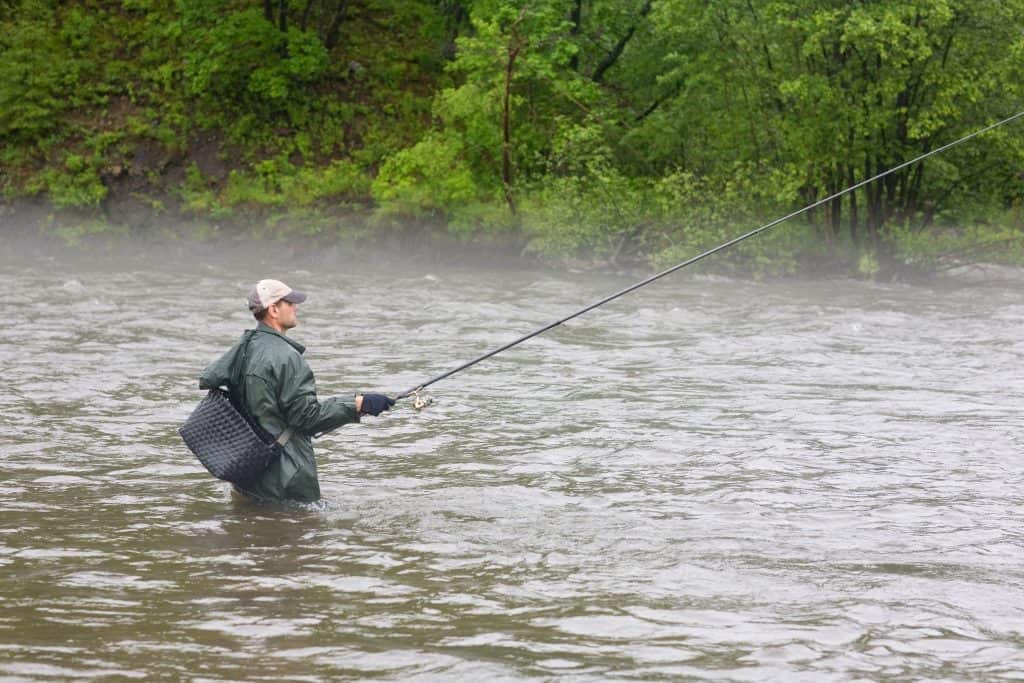
Tip 7: Fish Close First
A lot of people want to get carried away and hit the hard, long, fast cast right away. Sometimes it is best to start out by hitting those spots that might be right in front of you.
It is a lot easier to set the hook and get it where you want it to go. Not only that, but you can do a lot more with it. Sometimes on those long cast, you don’t even know what you are looking for. It’s fine to take your time and be patient.
Tip 8: Leader length
It is always good to try out new leader length from time to time. If you are just starting out, I would recommend 9 feet. That tends to be a fairly standard length. When you’re using dry flies on still water or wet fly fishing from a boat, you’ll need 12 to 20 feet at times.
If you are fishing with streamers, sometimes it is better to keep it under 8 feet and cast heavier flies. Trout are interesting fish and sometimes we have to accommodate them and their needs if we want to catch them.
Tip 9: Mimic Natural Prey
If you can see the common insects that live in the water, what is being eaten and what is being left, it is a good indicator of what kind of trout you are dealing with. If you can figure out what the trout are eating, you can figure out what you should use and mimic them.
Even if you prefer dry fly fishing, knowing what nymphs, larvae, and crustaceans are available beneath the surface with help you decide on what kind of fly to use.
Tip 10: Use Your Feet
Using your feet is going to be really important if you want to catch a lot of trout. As I was saying before, you don’t want to use very long casts, so move close if you have to. Make sure that you do this quietly though!
People that stay in the same place and don’t take advantage of the short casting will have a much harder day. It may sound like more work or like you are going to scare the trout away, but you will be so much better off.
The more you move your feet instead of arms, the better off you will be.
Tip 11: Hit That Cold Water
Trout love cold water. If you want to know where to go and where to fish, this will help. If you have ever heard of the Salmon River in Idaho, it is one of the best fly fishing spots for many reasons. But its water is always cold because it is runoff from the snowmelt that comes from surrounding mountains.
Just because fish love cold water doesn’t mean your body will though! Make sure you have the right gear so you aren’t freezing all day. If you don’t have super cold water by you, try fishing at moving water sources such as rivers and creeks. The woods are also a common place to find trout, and you can find good populations of lake trout in… well lakes.
Tip 12: Learning Your Streamside Manners
If you are a new angler, there are probably a few points of etiquette and politeness that you haven’t learned yet. There’s no shame in this because you’re just getting started! If you come into another person’s area, you will both have a worse day fishing.
Part of streamside manners is to cover your own areas and don’t intrude on someone else’s. If you find a good pool than that is awesome! Let others have a good time too and don’t be a hoarder around the area.
Keep things moving and maybe you will find an even better spot. Having good manners will actually help you catch more trout. I believe in karma, so if you treat other fishers well, the world will treat you well too.
Tip 13: Skate a Spider
Fishing dry flies on a dead drift is great, but skating has a long history too. Reluctant trout will often crush skittering dries in big, explosive strikes. The older flies are tied on short-shank hooks with long, oversize hackles that cause the flies to bounce and skim on the water.
Keep the fly and leader well greased, and use rod motion or the current drag to draw the fly across the surface, in a smooth pull or in stuttering twitches.
You can also skate-swing wet flies as well, lifting the rod until only the leader is on the water and the fly is kicking up a little rooster tail. It’s a terrific short-line, pocket-water technique.
The length of the butt section allows for 6 inches of line to be used when you’re nail-knotting it to the fly line. The other sections allow 2 inches each for the intermediate knots
Tip 14: Hand-tie Your Leaders
Yes, machine tapered knots are so much easier and more convenient. They make life easier, too, until you are out on the water and want to catch some more trout. Knowing the exact architecture makes it easy to rebuild a used and broken line on the stream.
If you know how to use these knots, it makes life easier for you. You get more versatility at a tiny fraction of the cost. The how-to can be hard to do, but with a little practice and a YouTube tutorial, you will be on your way.
Also, check out this tool that might help you when you’re getting ready to head out on the water.
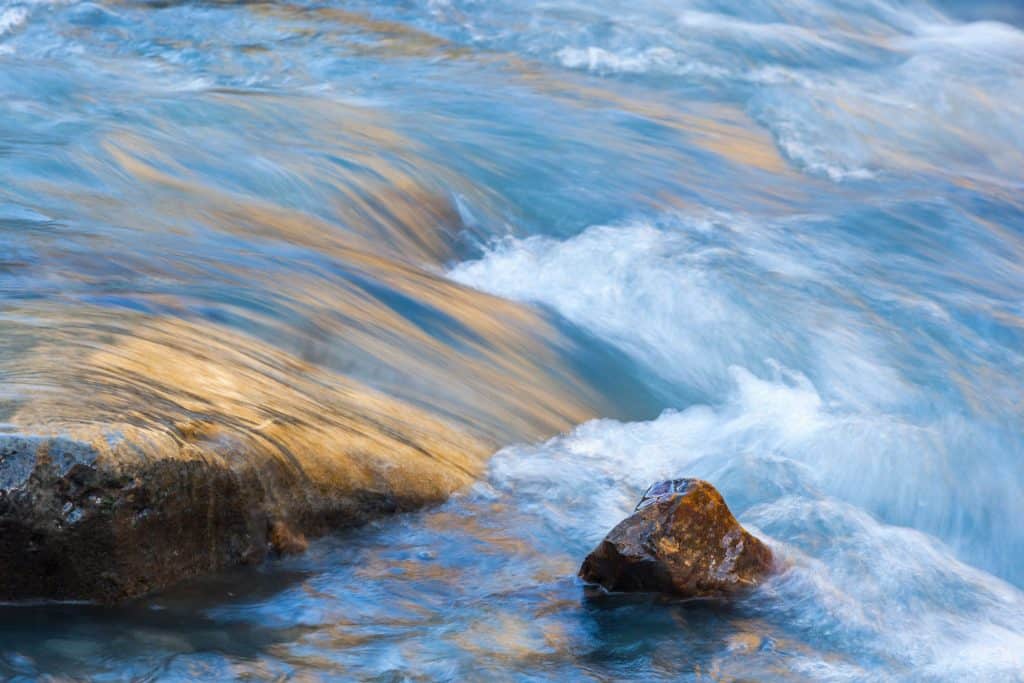
Tip 15: Fish the Seams
When you are fishing in streams, fish the seams. It’s a good little reminder and easy to remember. A seam is where the fast and the slow water meet and acts as like a little pocket. This is kind of where the trout usually like to hang out.
A lot of there food will go past there, so they are already looking for it. There food us usually floating down the stream so when they see something they dart forward for it.
If you know where to drop in, it’ll make your days easier out on the water.
Tip 16: Fish Near the Bank
The last tip, tip 15, is for streams. If you are fishing in a lake, you’ll want to fish in the bank. Another easy reminder with the (sort of) rhyme. Look for areas that have good vegetation and structure such as logs and rocks. These areas serve as both a source of food and protection for the trout.
It is actually ideal to get on a boat and fish towards the bank. If you are fishing from the bank, don’t try and cast super far. This will just waste your energy and time.
And even if it seems wrong, you can fly fish in a lake without a boat. And remember, in a lake, fish near the bank. Easy.
Tip 17: Shaded Areas
Fish in areas that are shaded, or try fishing just after the sun has set. Low light areas are often very successful. When you are fly fishing, you need to act as if you are their source of food. A lot of insects are active during sunset or when it is getting darker. If you can, try fishing at dawn and dusk.
Also, a huge benefit and half the reason I like to fish is the scenery. Nothing beats a sunset on the lake or river.
Tip 18: Know Your Trout
If you can understand and get inside the head of a trout, you will win all day, every day. Now, that’s easier said than done. Trout are actually really smart and can get pretty big because, well, they are smart and don’t go after bait like yours.
They are also really hard to see, even in the clearest of water. Their scales give them great camouflage. They can hide from eagles and bears really well too; so if you are looking and don’t see any, that doesn’t always mean that it’s
Tip 19: Seasons
Trout fishing changes with the
When you fish during the spawning season, this is when you will catch all the big fish, especially on creeks. The trout move to the creeks to be safer to spawn. During the spawn, they are not feeding, so you will need to aggravate them to get them to bite.
In the summer, the fish tend to hold low and deep in pools, so seek out the holes and you will find fish.
Tip 20: Follow the Bubbles
A lot of the time when you are working a seam and the water is moving fast, it can cause some foam, bubble line. A lot of little bugs, plants, and nutrients can get trapped in this area, making it popular with trout.
So try and follow the bubble line. When you see a foam or bubble line on the surface, there’s a good chance that feeding trout will be underneath it.
Tip 21: Mend Minimally
Mending is when you can toss a bend in your line as a hedge against drag. It is essential if you want to have good effective drifts.
But you can overdo it. The trick is to know when and how much. The best time to mend is actually just before you think you need it, so it takes time and practice.
Try to gauge how to mend the line with the minimal movement of the fly. With a shorter line, this often can be achieved simply by lifting the rod tip to place the line in the desired position.
Tip 22: Control Your Wrist
A huge mistake people make is going back a little too far on their back cast. While sometimes “it’s all in the wrist,” you have to remember that your arm drives and controls your wrist, and that is key.
A lot of fly fishers rely on and use their wrists way too much. This usually makes inaccurate casts and can end up hurting your hands, wrists, and arms.
If you are just starting out, don’t make this a bad habit. It can be a hard one to fix.
Tip 23: Let a Bad Cast Go
Sometimes we see a great spot and whether it was because we didn’t aim well, or a gust of wind, or we just aren’t that good yet, we miss.
Many people will load up and try back again as fast as they can. If you miss, let the line slide behind the trout before you go again.
This is a game of patience and if you can play that way, you will win the game. Wait until your fly goes behind your missed target and you won’t scare it off.
If you yank the fly right off the water, you can alert the fish that something is wrong. Let your bad cast float past them and then try again.
You are probably wondering why I haven’t talked much about lures yet, because they are key to fishing for trout. I wanted to just keep you on your toes. For my last 8 tips, I recommend you have these lures and apply them in the correct
Tip 24: Critters
Grasshoppers, beatles, crickets, and other bugs all fall into the waters and stream. if you know that they are there but don’t see any or much of them in the water, that is a good sign. It means the trout are around.
If you see this, you’ll want to use critter lures to imitate those bugs. This will make you seem like you’re just another one of them, floating along the stream. Fish are used to seeing this as a big easy snack for them, so take advantage of this.
Tip 25: Tubes
Tubes imitate zooplankton and other easy snacks all fish snack on. Honestly, they really don’t look like anything I have ever seen in the water. But they really get the job done and trout love it, so I’m not going to argue or complain. This is going to be something you want to keep on you.
Tip 26: Swimbait
Trout love to go after some smaller bait fish. If you are looking to go after some bigger trout and know they are around, this is a great lure. The best way to trigger strikes when they are up feeding on baitfish is a paddle tail swimbait that can disrupt the column.
Try out different things while you are out there and see what works best for you and your patterns and techniques.
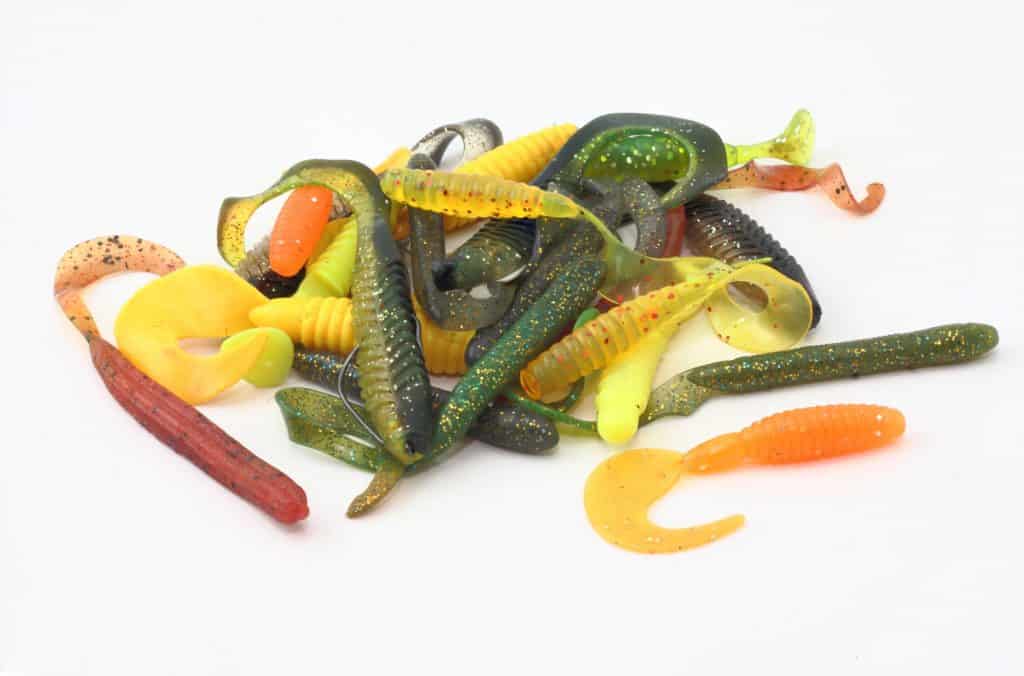
Tip 27: Worm Imitators
Okay, this may not be any secret or a trout expert type of bait, but it just works so well and for all types of fish. While live worms work for just about every fish, imitation worms actually work better for trout.
They are smaller than real worms and made of plastic. Since they come in brighter colors, they can be easily detected by the trout in muddy or moving waters. making it easier for both them and us.
Tip 28: Salmon Eggs
Trout are notorious scavengers, raiding spawning beds of other fish constantly to feed on their eggs. Yes, for those that are just starting out, it is pretty weird, but you will get used to it once you see how well it can work.
Trout can treat these salmon eggs like a buffet. Trout are sometimes too smart to go for fake lures, but sometimes eggs are just too tempting for them to ignore.
Tip 29: Cranks
Cranks aren’t my first choice when it comes to trout fishing, but if you know that there are some bigger fish in there, then this can be a really good lure.
Usually, trout will take on a crank if it is about 1/3 of there size, which is crazy. Imagine eating something a third of your size. Their teeth are really sharp though, so they can sometimes tear off more
Tip 30: Spoons
Spoons usually work best in colder weather, but can be used year long. You will see a lot of them with fancy feathers and wax worms on them. But their flashiness can annoy and entice fish into taking a big bite.
Tip 31:Spinners
Last but certainly not least, a HUGE tip would be to use spinners as a lure. They are a go-to, bread and butter that will bring in trout without a doubt. Easily changed in and out on a swivel, they get bit anywhere in a lake, but their flapping blades are suited to add flash to a river current.
They are an all-year, all around good lure that you should always have on you. If you have to make a choice between a spinner and any other lure, you should always choose the spinner.
Trout are always good to fish for and have so much to them. Try a few of these tips out. I hope that at least some of these were new and will prove helpful to your trips in the future!
Related Questions
What fish can you catch with a fly rod? Fly fishing can be used to catch many different kinds of fish. Some of the most common types include trout, grayling, salmon, pike, bass, panfish, and carp. Fly fishing can be used to catch both freshwater and saltwater species.
What is the most difficult fish to catch? A Blue Marlin is one of the hardest fish to catch. They are very rarely found on a hook and when they do, they will fight and fight. Blue Marlin usually will not be caught if you’re using fly fishing though.

